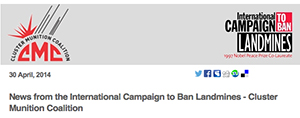27 April 2010
"It could be mined again" - Ongoing armed conflict in Myanmar/Burma threatens mine clearance efforts in Thailand
By Yeshua Moser-Puangsuwan, Landmine and Cluster Munition Monitor. The mountain is called Na Taung by the Burmese and Doi Ya Moo by the Thai, and its peak is on the Thai side of the shared border. The Thailand Mine Action Center (TMAC) arranged for me to visit the mountain in March 2010. It is the site of a former insurgent camp, but is now a Thai Army outpost.
"The insurgents moved across the border when we requested them to no longer use Thai soil" said Col. Monkol Pakamma, Deputy Commander of one of the Royal Thai Army's humanitarian demining units. From where I stood, only meters from the border, I could clearly see within the rugged fold of the western slope of the mountain several camps of the Karenni Army, a group which remains in armed conflict with Myanmar's military government. Further up the border, but quite close by, are camps of two other insurgent groups, the All Burma Student's Democratic Front and the Pa'O National Liberation Army.
The Thai Army officer confirmed that both groups are militarily active and that the areas fronting these camps are thick with landmines. To reach the top of Doi Ya Moo, it was necessary to traverse an area which had just been cleared by the Thailand Mine Action Center. It was formerly a transit route used by both the Karenni Army and the Burmese Army to attack one another across a short span of Thai soil. Both mined the route. After two Thai villagers and a border patrol soldier stepped on mines in the area TMAC was asked to clear it.
Local villager's wished to have safe access to the area to collect forest products growing in the jungle. Thailand was one of the first countries in Southeast Asia to join the 1997 Mine Ban Treaty, which required clearance of all mines within 10 years. While the passage to the peak of Doi Ya Moo has been cleared, the few meters between where I stood and the border, just outside the camps bamboo fence, remained mined.
"Although we have determined that there are mines there, the precise line of the border must be agreed between Thailand and Burma before we can proceed with clearance." I was told by one of the soldiers who went on to explain that the exact boundary is uncertain due to descrepancies caused by the fact that Thailand uses metric maps and Burma uses maps based on the British mile. As we left the area, Col. Monkol worried about the future. Even though his team had demined the area it could for now, "I can't say that the same parties might not mine it again in the future.", he said.
Last year, Thailand had to request an extension of time to meet its mine clearance obligations under the Mine Ban Treaty. However, with all warring factions across frontier engaging in mine warfare, the threat of new mine pollution in Thailand remains real. Ongoing war virtually assures that border demarcation will not take place any time soon, and hold Thailand's ability to meet its Treaty obligations hostage, and Col. Monkol will remain a worried man.
Yeshua Moser-Puangsuwan is an editor and research coordinator for Landmine and Cluster Munition Monitor for Asia (ban policy) and for non-state armed groups (global), and the country researcher on Myanmar/Burma.


